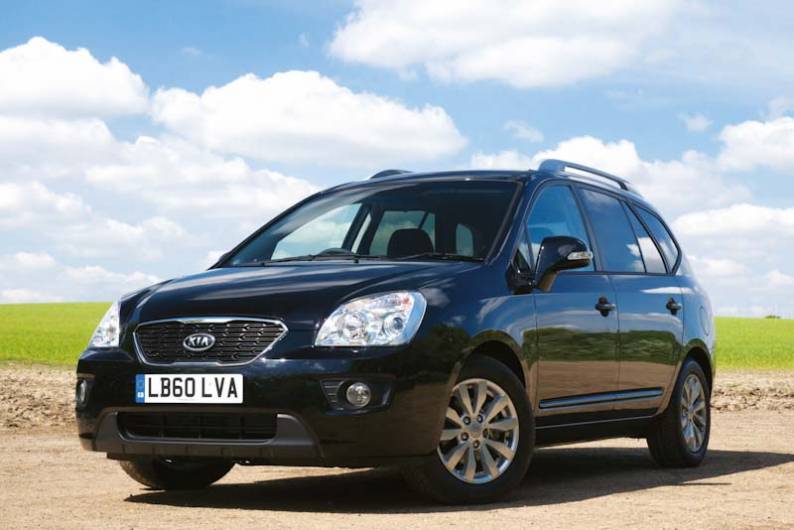
RAC sale – up to 33% off*
• Roadside cover from £5.29 a month†
• We get to most breakdowns in 60 mins or less
• Our patrols fix 4/5 breakdowns on the spot

BY ANDY ENRIGHT
Introduction
The Kia Carens might not be the obvious choice in the used mini-MPV sector but it offers a number of compelling arguments to those who research the market diligently. If you have a growing family and are working hard to balance the financial pressures this can bring, the Carens can go from an anonymous irrelevance to suddenly becoming a very good thing. Here's how to grab a good used buy.
Models
(5 dr MPV 1.6 petrol, 1.6 CRDi diesel [1, 2, 3])
History
The first Carens arrived way back in July 2000, so this is a model that had a decade's worth of development by the time the car we look at here arrived. A second generation Carens arrived in 2006 and the 2010 car was, in effect, a facelift and mechanical development of that car. Call it a Mark 2.5 if you like. The basic proposition was largely unchanged. It's a compact MPV offered with either five or seven seats. You know, the kind of car that most of the mainstream brands will charge you the best part of £25,000 for with the diesel power most will want - more if you want the kind of third row seating that'll be vital for larger broods.
Like many families, Kia thinks that's a ridiculous amount of money for a car of this kind, so for around £4,000 less than something Scenic or C-MAX-like, they'd roll a Carens onto your driveway. Even at that kind of saving, you wouldn't have thanked them for the original first generation version, but these later cars were a much improved proposition, thanks in no small part to the more efficient 1.6-litre engines. The trim structure of 1,2, and 3 was incredibly easy to figure out and the Carens did steady, if unspectacular, business right up to its replacement, which was first shown at the Paris Motor Show in autumn 2012.
What You Get
The key decision in this sector that has taxed the minds of many major manufacturers is whether to develop a five or a seven-seat design. Kia neatly sidestepped this quandary with this model by offering it in both five and seven seat guises. Of course, the ultimate test of how well these vehicles are packaged comes when you try to lever an adult into the back row of a seven seat version. With most mini-MPVs, their knees will be up around their ears. Next time you get in any other seven-seat mini-MPV, get a tape measure and check the height between the top of the seat cushion and the floor. It's often around four or five inches - which is frankly laughable. Kia got around that problem here by designing a shallow petrol tank that sits inside the rear suspension subframe. This drops the floor height by some 40mm, allowing for a more relaxed seating position. The Korean company reckons that adults of 5'11" will be comfortable in the rearmost row of seats in the seven seat model, although that may be pushing it.
Longer, wider and taller than its predecessor, this MK2.5 Carens looks quite polished. If you didn't know what it was, you might be astonished to hear that when new, this was one of the cheapest mini-MPVs you could lay your hands on. Whichever model you choose - 1.6-litre petrol or 1.6-litre diesel - you should find your car to be very decently equipped, despite the bargain basement pricing. Features fitted across the line-up include alloy wheels, tinted glass, air conditioning, all-round electric windows and power mirrors, a 6-speaker MP3-compatible CD stereo with AUX and USB sockets, remote central locking and various 12V power sockets. Further up the range, you'll find features like roof rails, Bluetooth connectivity for your mobile 'phone, privacy glass, reverse parking sensors and leather trim. Safety kit includes twin front, side and curtain airbags, plus ESC stability control and the usual electronic assistance for braking and traction.
What You Pay
Please fill in the form here for an exact up-to-date information.
What to Look For
The interior of the Carens is tougher than you may expect given its lowly price but it's well worth checking for rips, stains and other damage to upholstery and minor trim parts. Inspect for parking knocks and make sure that tyre wear looks normal, as the Carens can have its tracking quite easily knocked out of kilter by savage bumping over kerbs. Kias bear up pretty well reliability-wise, but do check for its service history and contact a few franchised dealers to try to find the best bargain available. Also, check that the car you're after has been properly serviced to maintain warranty cover. The most significant recall issued by Kia related to faulty brake-light operation, so make sure the alteration has been carried out.
Replacement Parts
(Estimated prices, based on a 2010 1.6 2 CRDi) Kia spares remain good value for money and Carens parts are no exception. A clutch assembly is around £275, whilst front brake pads weigh in at around £45. An alternator will cost around £150 and for a starter motor you'll be looking at £145.
On the Road
We're always reading about MPVs that offer 'a rewarding driving experience'. All very nice. And all pretty pointless. Cars of this kind are largely functional items, with comfort and composure greater priorities than power and handling. So it is here. Which means that if you're running late for the school play on a twisty road, you will notice more body roll than you'd get in a C-MAX or a Scenic. And power steering that's rather lifeless.
The trade-off though, is ride comfort that at higher speeds or on major roads is almost as good as anything in the class. And in-town manoeuvrability that makes this car pretty much as wieldy as any Focus-sized family hatch, though the small rear window can make reversing a little tricky until you get used to it.
The underpinnings of this vehicle are shared with Kia's unloved Magentis saloon, a car now consigned to history. Better news though is that the engineware in the more recent MK2 Carens models you should seek out is borrowed from a far more class-competitive Kia model, the cee'd family hatch. That means that on a later Carens MK2, instead of the thirsty 2.0-litre engine this car was launched with, you get a choice of 1.6-litre units, a 130bhp petrol model with a five-speed manual gearbox and a 126bhp CRDi diesel with a six-speed manual.
Both make sixty from rest in about 12s on the way to a top seed of about 110mph, but it's the diesel that feels far more responsive thanks to its 260Nm of torque - which means that you don't have to row the thing along with the gear lever in and out of town. True, the diesel is rather clattery upon start-up, but once on the move, refinement is pretty much up to the standard of any other car in this class.
Overall
The 2010 to 2013-vintage Carens is an interesting buy in the small but spacious end of the people carrying sector. It's a five or seven-seat design that does the family duties extremely well and will come with the remainder of its excellent warranty in place. If you like the price of a used car but not the headaches that often come part and parcel with it, this Carens is the mini MPV for you. It's not the most exciting car to look at or drive, but it does a very solid job at an affordable price. For many family buyers, that's the key priority.







